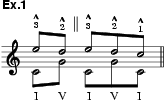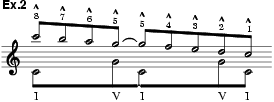
(Ger. Unterbrechung).
In Schenkerian analysis (seeAnalysis, §II, 4) the principal method of Prolongation applied to the fundamental structure (Ursatz) of a tonal piece, achieved by ‘interrupting’ its progress after the first arrival on the dominant; this interruption requires a return to the starting-point of the fundamental structure. The symbol for an interruption is a double stroke on the same line as the capped arabic numerals representing the melodic scale steps of the fundamental line (Urlinie), as shown in ex.1. The dominant that immediately precedes the interruption is called theDivider.

When the fundamental line encompasses a 3rd (as in ex.1) or a 5th, the interruption occurs after the arrival on 2. When it covers a full octave, however, a true interruption is impossible: for if it were to take place after either 7 or 2, the return to the octave would create the impression of an upper or lower neighbour (in C major, C–B–C or C–D–C); and if it occurred after 5, the subsequent return to 8 would produce consecutive octaves. It is possible, however, to divide the fundamental line at 5 by having the bass return to the tonic while the 5 is tied over (ex.2); this is the nearest equivalent to interruption when the fundamental line encompasses an octave (Schenker: Der freie Satz, 1935, §§76 and 100).

As a method of prolongation, interruption is of utmost significance for musical form, providing the structural basis of two-part song form and, by extension, of sonata form: the return to the starting-point of the fundamental structure corresponds to the beginning of the recapitulation in the musical foreground.
WILLIAM DRABKIN